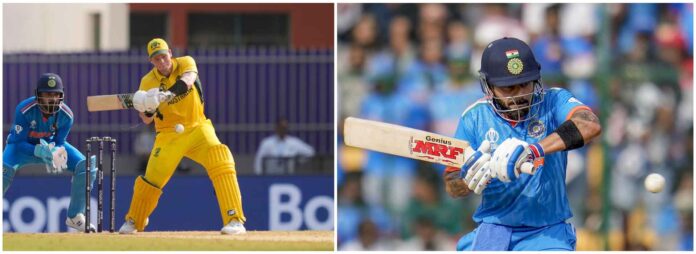In a crucial moment during the league match between India and Australia, Virat Kohli showcased his prolific form with an impressive knock of 85. However, his innings could have taken a different turn if Australia had capitalized on a chance he offered off the bowling of Josh Hazlewood. On 12 runs, with India struggling at 20/3, Mitchell Marsh dropped a diving catch after Kohli top-edged a Hazlewood short ball.
Given Kohli’s outstanding form, marked by eight fifty-plus scores in his last ten innings, breaking the Kohli barrier becomes imperative for Australia. The ability to dismiss him early holds the key to accessing India’s formidable middle-order. Hazlewood, with his remarkable new-ball spell in the semi-final against South Africa, emerges as a crucial player for Australia in this high-stakes encounter. The World Cup final in Ahmedabad promises an intense battle, and the Kohli-Hazlewood dynamic adds an extra layer of intrigue to the narrative.
Rohit Sharma vs Mitchell Starc
Two years ago at the ICC Men’s T20 World Cup, it wasn’t a shock when Shaheen Afridi trapped Rohit Sharma in front for a golden duck in the very first over. The left-arm pace bowler has consistently troubled Rohit, particularly in ODIs, where the Indian opener has been dismissed 33 times by left-arm pacers. Impressively, 22 of those dismissals occurred within the first 10 overs of the innings.
This trend continued in the current World Cup when Dilshan Madushanka deceived Rohit with a delivery that eluded his bat, crashing into the stumps. As the ICC Men’s Cricket World Cup final approaches, the battle between Rohit Sharma and left-arm pace, exemplified by Shaheen Afridi, becomes a key storyline to watch. The early exchanges in the innings could prove decisive, and Rohit’s ability to handle the left-arm pace threat will be a critical factor for India.
Mitchell Starc and the Australian team are acutely aware of the threat Rohit Sharma poses, especially during the Powerplay. The Indian skipper has a formidable record of swinging matches in the first 10 overs, scoring at an outstanding rate of 133.08. To counter this, sending Rohit back early becomes a crucial objective, and Mitchell Starc emerges as a key player for Australia in achieving this.
Starc, despite a relatively inconsistent form in the tournament, showcased a resurgent performance in the semi-final in Kolkata. However, the exaggerated movement seen there may not be as prominent in Ahmedabad. The stakes are high in this monumental occasion, and the battle between Starc and Rohit is poised to be decisive. Despite a history that might raise questions, Rohit has proven his mettle, as seen in the semi-final against Trent Boult. As the World Cup final approaches, all eyes will be on this compelling matchup, waiting to see who blinks first in what could indeed be a game-changing duel.
Glenn Maxwell vs Kuldeep Yadav
In the semi-final clash against South Africa at the Eden Gardens, Glenn Maxwell entered the fray with the score at 133/4. His time at the crease, however, was short-lived. Tabraiz Shamsi’s quicker delivery beat Maxwell on the first ball, and the Australian batsman’s innings lasted only five balls in total. In an attempt at a wild, across-the-line hoick, Maxwell was comprehensively dismissed by the South African wrist spinner, adding a twist to the middle order battle in a critical moment of the match. The short-lived innings raised questions about Maxwell’s approach and the impact it might have had on Australia’s overall innings.
Glenn Maxwell’s flamboyant style of play is well-known, and while not every day sees him taking on spinners with such audacity, his dismissal in the semi-final against South Africa had an uncannily familiar tone. On a similar turning track in Chennai against India, Maxwell had fallen in the exact same fashion to Kuldeep Yadav, another left-arm wrist spinner. The recurrence of the dismissal raises questions about Maxwell’s adaptability against this particular type of bowling and adds an intriguing layer to the narrative of his confrontations with left-arm wrist spinners in high-stakes matches.
If Ahmedabad presents another two-paced wicket, Glenn Maxwell might approach his innings with a degree of caution, considering the significant turn that Kuldeep Yadav can extract and the threat it poses to his aggressive style of play. The dismissal in Chennai marked the third time Maxwell fell victim to Kuldeep, highlighting the challenge posed by the left-arm wrist spinner.
However, despite the dismissals, Maxwell has demonstrated a remarkable scoring rate of 143.5 against Kuldeep in ODIs. This statistic underscores Maxwell’s ability to counterbalance the challenges presented by Kuldeep’s unique spin and suggests that while there might be occasional setbacks, Maxwell remains a potent force capable of turning the tide in his favor against the Indian spinner. The upcoming World Cup final in Ahmedabad holds the promise of yet another intriguing chapter in this battle between bat and ball.
Steve Smith vs Ravindra Jadeja
One of the captivating storylines of the enthralling Border-Gavaskar Trophy series earlier in the year was the intense battle between Ravindra Jadeja and Steve Smith. The defining moment occurred in the first Test in Nagpur, where Jadeja completely deceived Smith, compelling him to play outside the line and resulting in a chaotic rearrangement of his stumps. This pivotal wicket set the tone for their subsequent encounters in the series.
Jadeja continued his dominance over Smith, dismissing the Australian batsman two more times during the series. The rivalry extended beyond the Border-Gavaskar Trophy, reaching the pinnacle in the ICC World Test Championship final in England, where Jadeja claimed Smith’s wicket once again. As the cricketing world gears up for the World Cup final in Ahmedabad, the prospect of Jadeja renewing his battle against Smith adds an intriguing layer to the contest, promising another chapter in this gripping rivalry.
In the cricketing battles of 2023, Ravindra Jadeja has emerged as a nemesis for Steve Smith, dismissing him a total of five times across formats. The most recent, and arguably the most impressive, was in the league stage game in Chennai, where Jadeja’s delivery beat Smith comprehensively, dismantling his stumps.
While Smith boasts a stupendous ODI record against Jadeja, scoring at a rate of over 100 and being dismissed only twice in more than 200 balls, the challenge becomes amplified if the ball starts to generate clouds of dust in Ahmedabad on Sunday. The conditions in the World Cup final may nullify Smith’s historical prowess against Jadeja, setting the stage for another riveting chapter in their ongoing cricketing saga.
Mohammed Shami v David Warner
As the World Cup final approaches, the challenge for teams, especially the Australians, lies in finding a way to counter the threat posed by Mohammed Shami. The venue, with its familiarity over two IPL seasons, emphasizes what Shami is capable of in short-ball formats.
Shami’s effectiveness against left-handers, in particular, has been remarkable in this tournament. In just 52 balls, he has dismissed left-handers eight times, maintaining an astonishing average of 4.00 against them. The Aussies will need a strategic approach and resilience to navigate Shami’s potency, especially against their left-handed batsmen, in the high-pressure environment of the World Cup final. The battle between Shami and the Australian batsmen promises to be a key subplot in determining the destiny of the coveted trophy.
Mohammed Shami’s remarkable success against left-handers in the current World Cup is highlighted by the fact that, on average, every seventh ball he bowls to a left-hander results in a wicket. This exceptional statistic underlines Shami’s proficiency in exploiting the weaknesses of left-handed batsmen in the tournament.
However, if there’s one player unfazed by such statistics, it is David Warner. The Australian opener has displayed a fiery approach against right-arm pacers throughout the tournament. While this aggressive approach has yielded positive results, it has also led to Warner’s dismissal five times against right-arm pacers. The intriguing battle between Warner and Shami in the World Cup final will be a captivating storyline, as Warner aims to overcome the statistical odds and make a significant impact against the Indian pacer.
Given Mohammed Shami’s exceptional success against left-handers in the World Cup, particularly his ability to dismiss them every seventh ball on average, it poses an intriguing question for India’s bowling strategy. The Australians have their only two left-handers in the top seven—David Warner and Travis Head—batting at the top two positions.
While Mohammed Siraj is proficient against left-handers himself, the temptation for India could be to utilize Shami’s exceptional numbers and skills by deploying him with the new ball. This strategic move would aim to capitalize on Shami’s ability to exploit the weaknesses of left-handed batsmen early in the innings, potentially providing India with crucial breakthroughs in the powerplay. The decision on whether to unleash Shami upfront will likely depend on the team’s analysis of the match situation, conditions, and the desired impact against the Australian top order in the World Cup final.






















